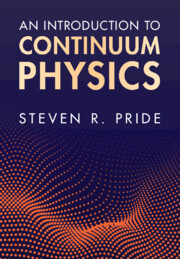12 - Green’s Functions
from Part II - Mathematical Methods
Published online by Cambridge University Press: 06 February 2025
Summary
In this chapter, the Green’s function method is developed that shows how boundary values, initial conditions, and inhomogeneous terms in partial-differential equations act as source terms for response throughout a domain. The Green’s function of a given partial-differential equations is the response from an impulsive point source and satisfies homogeneous versions of whatever boundary conditions the actual response satisfies. The Green’s function propagates a response from source points to receiver points. After developing this method for the scalar wave and diffusion equations and obtaining the Green’s functions of these equations in infinite domains, the focus turns to the Green’s function method for the multitude of vectorial continuum responses governed by equations derived in Part I of the book. In particular, elastodynamics, elastostatics, slow viscous flow, and continuum electromagnetics are analyzed using the Green’s function method. The so-called Green’s tensors for each of these continuum applications in an infinite domain are obtained using the Fourier transform and contour integration.
Keywords
- Type
- Chapter
- Information
- An Introduction to Continuum Physics , pp. 627 - 671Publisher: Cambridge University PressPrint publication year: 2025

